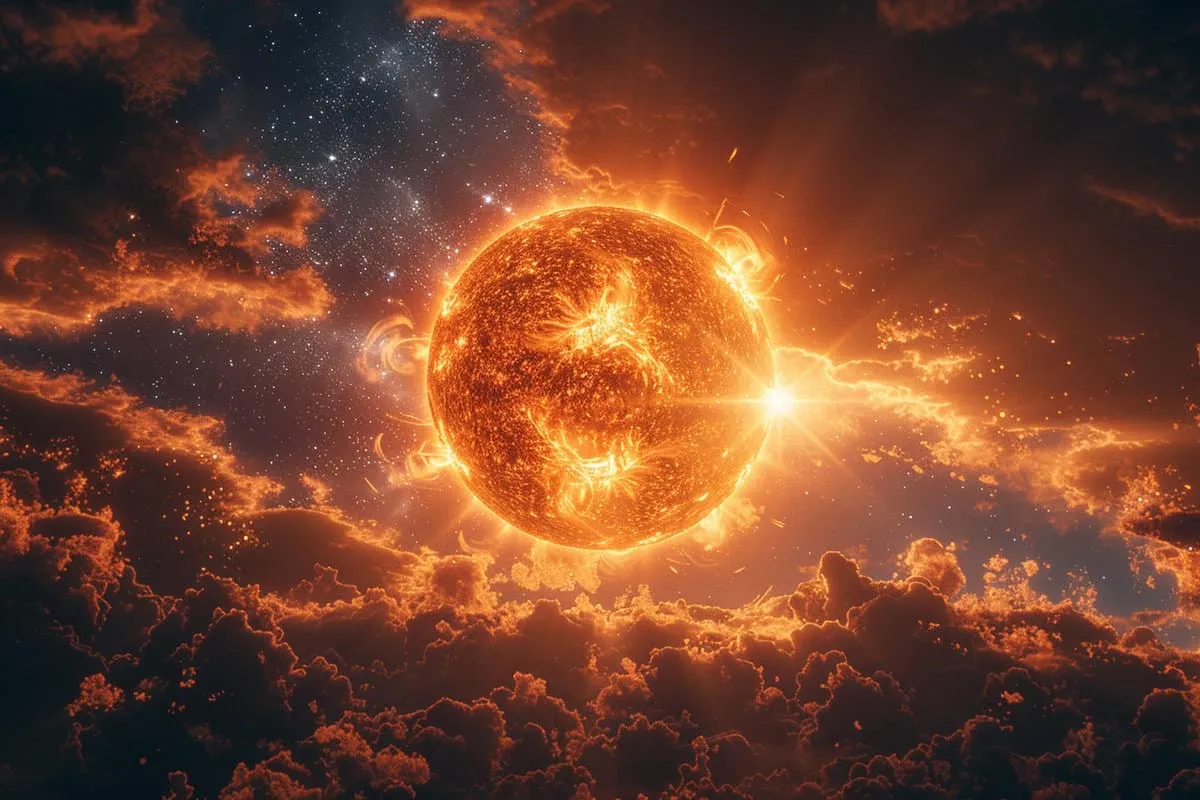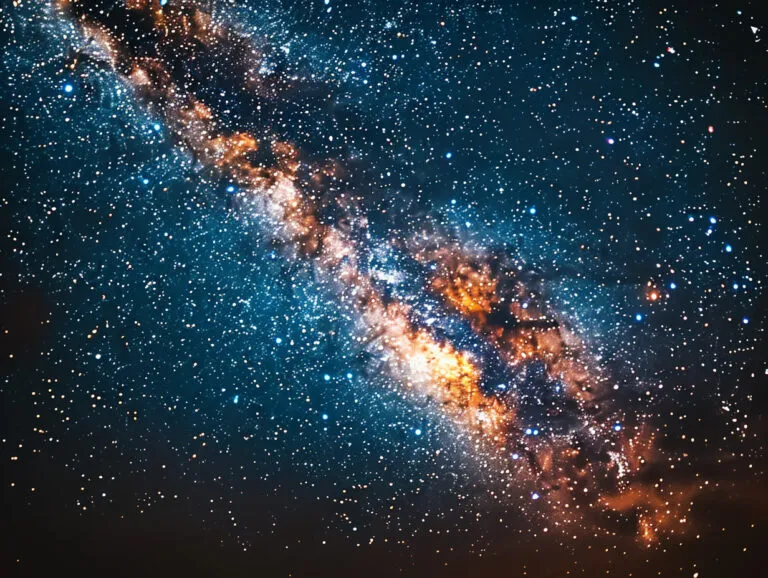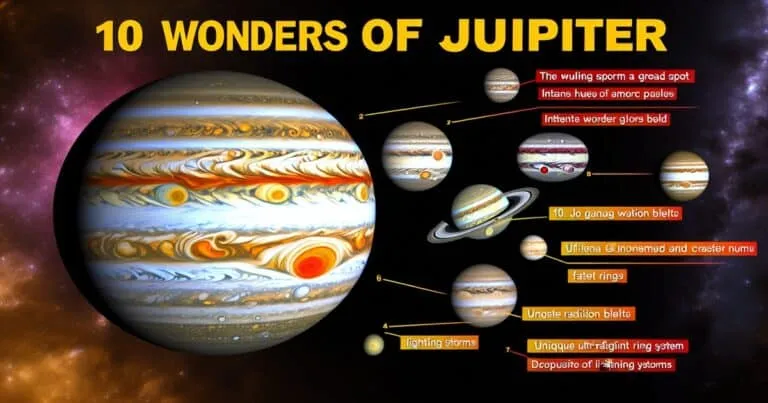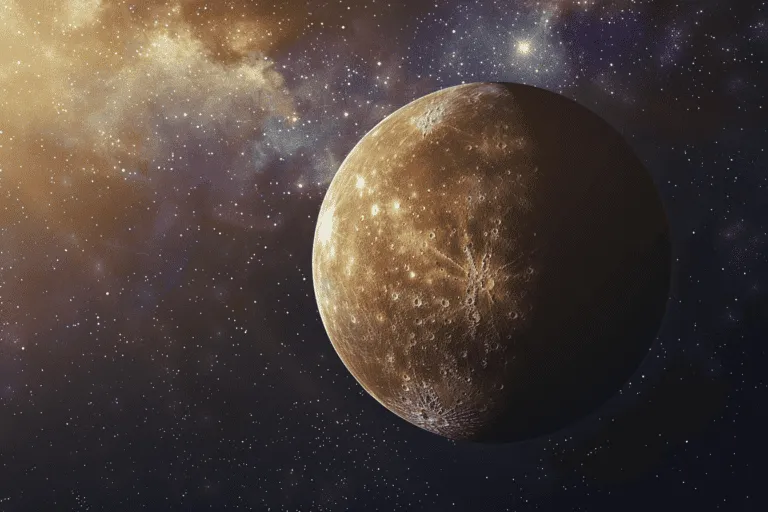Sun Facts: Essential Guide to Our Solar System’s Heart
The sun, our very own star in the solar system, is a powerhouse of energy and mystery. From its crucial role in supporting life on Earth to its influence on our weather systems, the sun touches every aspect of our existence.
But there’s more to this celestial giant than meets the eye.
With fascinating phenomena like solar flares and the mysterious dark spots that dot its surface, the sun holds secrets that scientists are still unraveling today.
Ready to soak up some illuminating facts about this fiery ball in the sky? Scroll down for a beam of knowledge that will light up your curiosity.
The Sun is a Star at the Center of Our Solar System
The Sun is not just any star; it’s the heart of our solar system. Imagine a giant fiery ball in the sky that keeps us warm and brightens our days. That’s the Sun for you!
It showers Earth with light and heat, without which life as we know it wouldn’t exist.
Compared to Earth, the Sun is colossal. To put things into perspective, about 1 million Earths could fit inside the Sun if it were hollow.
This immense size allows it to hold all planets in their orbits around it, from Mercury all the way out to Neptune.
Life on Earth relies heavily on sunlight. Plants need sunlight for photosynthesis—this process lets them make food and release oxygen, which all animals including humans breathe.
Besides giving energy to plants, sunlight also helps keep our planet warm enough for living beings to survive.
But there’s more to the Sun than meets the eye:
- Solar Prominence: These are huge arcs of gas that erupt from the sun’s surface.
- Sunspots: Dark spots on the sun that are cooler than other parts.
- Outer Atmosphere: The part of the sun we can see during a total solar eclipse.
It’s Made Mostly of Hydrogen and Helium
The Sun, our closest star, is a massive ball of energy that lights up our days and sustains life on Earth. What’s fascinating is that it’s made mostly of hydrogen and helium.
These are the lightest elements in the universe, which makes them perfect fuel for the sun’s powerhouse.
Hydrogen atoms in the Sun collide and fuse together in a process called nuclear fusion. This incredible process produces vast amounts of energy—energy that eventually reaches us as sunlight.
Imagine billions of tiny power plants all working together at once; that’s kind of what’s happening in the Sun!
This process not only keeps our solar system’s central star burning bright, but it also means that its composition isn’t too different from other stars scattered across galaxies far away.
When astronomers look into space, they see countless stars shining back at them, many with similar makeup to our own Sun.
At its core and throughout its different parts, these reactions involving hydrogen and helium particles keep churning out light and heat. It’s like a never-ending fireworks show where atoms are both the sparklers and spectators.
The Sun’s Surface Temperature is Around 5,500 Degrees Celsius
Imagine holding a piece of metal under the summer sun. It gets hot, right? Now, think about the Sun’s surface temperature being around 5,500 degrees Celsius (9,932 degrees Fahrenheit).
That’s not just hot; it’s scorching! This incredible heat is enough to melt almost anything we have on Earth.
But here’s something fascinating—the Sun doesn’t have a solid surface like our planet. Instead, its outer layers are made of gases that are constantly moving and changing temperatures.
These gases make up what we see as the ‘surface’ of the Sun.
What’s even more interesting is that this sweltering 5,500 degrees Celsius isn’t consistent throughout. The Sun has different layers with varying temperatures. As you move away from the surface towards its core, things get even hotter!
The core itself reaches mind-blowing temperatures over 15 million degrees Celsius! Compared to that inferno, the surface seems almost cool.
This temperature difference between the outer layers and core plays a crucial role in how energy moves through and out of the Sun. It drives solar phenomena such as sunspots and solar flares which can affect us here on Earth.
The Sun is About 4.6 Billion Years Old
The Sun is a massive star at the center of our solar system, and it’s about 4.6 billion years old. Imagine that! It was formed from a giant molecular cloud which collapsed under its own gravity.
Now, when we say the Sun is middle-aged, we’re comparing it to other stars in our galaxy. Some stars are just starting their lives, while others are on their way out. The Sun is right in the middle of its life cycle.
What’s fascinating is that the Sun still has about 5 billion years left before it runs out of fuel. That’s like if you were only halfway through your day at school or work—there’s still plenty more to come!
Here are some fun facts to think about:
- Our entire solar system revolves around this gigantic star.
- Without the Sun, life as we know it wouldn’t exist on Earth.
- Every second, millions of tons of hydrogen in the Sun get converted into helium through nuclear fusion. This process releases energy and gives us light and warmth.
It Takes Light Approximately 8 Minutes to Travel from the Sun to Earth
The vast space between our Earth and the Sun is bridged by light in what seems like an instant but actually takes about 8 minutes. This fact alone showcases how incredibly fast light travels, making it the fastest thing in the universe.
Imagine this: if you could travel at the speed of light, you would circle around Earth over seven times in just one second.
The speed of light is a mind-boggling 299,792 kilometers per second. To put that into perspective, it’s over 186,282 miles per hour!
This journey of sunlight to Earth isn’t just a straight dash across space; it’s a race against time and distance that highlights two key things:
- The incredible vastness of our solar system.
- The unmatched speed at which light travels.
Every beam of sunlight we see has traveled this immense distance just to reach us, bringing warmth and energy to our planet. It’s fascinating to think about how every sunny day connects us with something as distant as the Sun through these particles of light.
The Sun’s Gravity Keeps the Solar System Together
The sun is like a big magnet, but instead of attracting metal, it uses gravity to keep our solar system together.
It has the strongest gravitational pull around, way stronger than any planet or moon.
This powerful force of gravity makes sure everything orbits around the sun just right. Planets, including Earth, follow paths carved out by the sun’s gravity. Without it, planets would wander off into space.
Not just planets, but also asteroids and comets are held in this cosmic dance by the sun’s gravity.
Imagine throwing a ball in a circle with a string attached; that’s kind of how gravity keeps these objects orbiting.
Pressure plays its part too but in another scene entirely—deep inside the sun where it helps create all that energy and light we see.
Solar Activity Affects Earth’s Climate and Technology
Solar flares light up the sky with auroras, creating breathtaking views in polar regions. These bursts of solar material are not just a pretty sight; they pack a punch that can disrupt our technology on Earth.
Sunspots play a big role in this cosmic dance. They’re dark areas on the sun, cooler than their surroundings.
Scientists have found that these spots go through phases, increasing and decreasing over an 11-year cycle known as the solar cycle. When there are lots of sunspots, we get more solar activity like flares.
The solar wind is another player from our star affecting us here at home. It’s a stream of charged particles released from the outer layers of the sun, constantly flowing past Earth.
This wind interacts with Earth’s magnetic field, sometimes causing storms in our planet’s magnetic environment.
These interactions aren’t just about lights in the sky or scientific curiosity:
- Auroras might be beautiful but intense solar activity can lead to power outages.
- Sunspots indicate periods when we might expect more or less solar flare activity.
- Solar wind influences not only auroras but also has an impact on satellite operations and communications.
The Sun Will Eventually Become a Red Giant
As our sun runs out of hydrogen fuel, a significant change awaits it. This event marks the end of what scientists call its main sequence phase.
Here’s what happens: the sun will expand massively, becoming a red giant.
During this giant phase, it will engulf the closest planets to it, Mercury and Venus.
Imagine the sun growing so large that these planets get swallowed up! That’s how massive it will become.
Why does this happen? It’s all about fuel.
The sun burns hydrogen in its core to keep shining bright. But when this fuel starts running low, things change inside the sun. It begins to collapse under its own weight but then bounces back by expanding outward.
This expansion into a red giant is not just about size; it also involves cooling down in some regions while heating up in others like the transition region or zone around the core.
After reaching its peak as a red giant, what comes next for our star? It won’t stay huge forever.
Eventually, it’ll shed its outer layers and shrink down to become one of those white dwarfs—small yet incredibly dense stars left after giants die off.
Solar Flares Can Disrupt Communications on Earth
Solar flares are like giant explosions on the sun. They send out powerful electromagnetic radiation.
Imagine the sun throwing a massive energy tantrum that can reach all the way to Earth.
This energy can mess with our power grids and satellites. Power grids give us electricity, and satellites help with things like GPS and phone calls. When solar flares hit them hard, it’s like unplugging your Wi-Fi router in the middle of an important video call.
The more solar storms we have, the trickier it gets for our technology to stay reliable.
It’s not just about losing Wi-Fi or having a blackout at home. Big companies and even countries need to think about how to keep everything running smoothly when the sun acts up.
Coronal mass ejections (CMEs) often come with these flares. Think of CMEs as huge bubbles of gas thrown out by the sun, which can make these disruptions even worse.
Missions into space now have to plan for these events too.
Scientists working on satellites or planning trips beyond Earth need to figure out how not to let their tech get fried by a sudden solar flare.
The Sun Contains 99.8% of the Solar System’s Mass
The Sun is not just any star; it’s a giant among giants, holding 99.8% of the entire Solar System’s mass.
Imagine all the planets, moons, asteroids, and comets combined—they only make up a tiny 0.2%. This fact alone puts into perspective how overwhelmingly massive the Sun really is compared to everything else we see in the sky.
This immense mass isn’t just for show; it has a crucial role in keeping our Solar System together.
The Sun’s gravitational force acts like a giant anchor, determining how each planet moves. Because of this strong pull, planets orbit around it in predictable paths.
Here’s an interesting way to think about it:
If you had a classroom where everything weighed almost nothing except one huge desk that was super heavy, everything would naturally move towards and around that desk because of its weight pulling them close—this is similar to how gravity works with the Sun and planets.
Moreover, this gravitational force doesn’t stop at just keeping things in orbit; it also affects their speed and distance from the sun.
Frequently Asked Questions
What exactly is the Sun in our solar system?
The Sun is a massive star at the center of our solar system. It’s like the neighborhood’s big boss, keeping everything together with its gravity.
Is the Sun made of anything special?
Yep, it’s mostly hydrogen and helium. Think of it as a giant, glowing balloon filled with gas that keeps on burning.
How hot does it get on the Sun’s surface?
It sizzles at around 5,500 degrees Celsius! If you think summer days are hot, the Sun takes it to another level.
Just how old is the Sun?
Our stellar neighbor is about 4.6 billion years old. That’s ancient—way older than any dinosaur!
How long does sunlight take to reach us on Earth?
Sunlight zips through space for about 8 minutes before hitting our planet. So when you feel those rays, remember they’ve been on quite a journey!
Why doesn’t everything in space just float away from each other?
The Sun’s gravity acts like an invisible leash, keeping all planets and objects in check within our solar system.
Can what happens on the Sun affect us here on Earth?
Absolutely! Solar activity can mess with our climate. It can also disrupt technology like GPS and communications systems. It shows we’re more connected to space weather than we might think.
Will the sun keep shining forever as it does now?
Not forever. Eventually, it will become a red giant. But don’t worry – this won’t happen for another few billion years.





